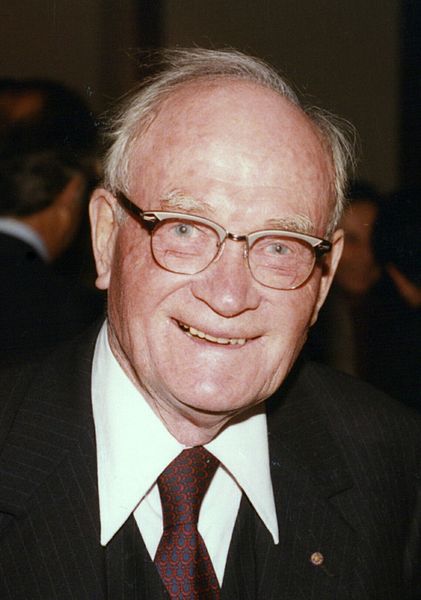<Back to Index>
- Geophysicist Cecil Howard Green, 1900
- Singer and Composer Barbara Strozzi, 1619
- General of the U.S. Army Air Forces George Churchill Kenney, 1889
PAGE SPONSOR

Cecil Howard Green (August 6, 1900 – April 11, 2003) was a British born American geophysicist who trained at the University of British Columbia and the Massachusetts Institute of Technology.
He was a founder of Texas Instruments. With his wife Ida Green, he was a philanthropist who helped found the University of Texas at Dallas, Green College at the University of British Columbia, St. Mark's School of Texas, and Green College at the University of Oxford. They were also major contributors to the Cecil H. Green Library at Stanford University, and the Cecil & Ida Green Building for earth sciences at MIT (designed by I.M. Pei).
Born in Whitefield, England, in 1900, Green and his family migrated to Nova Scotia, Toronto, Canada, and San Francisco, United States. There, as a witness to the great 1906 San Francisco earthquake, young Cecil received his first lesson in geophysics, the field in which he would make his fortune. The family moved to Vancouver, British Columbia, where Green attended UBC for two years before transferring to The Massachusetts Institute of Technology, earning both a bachelor's and master's degree in electrical engineering in 1924.
Green met Ida Flansburgh in 1923 while working on his master's thesis at the General Electric Research Center in Schenectady, New York. They were married for 60 years, until her death in 1986. The couple crisscrossed the country five times, making their home in auto camps and tents. Green worked as an engineer for electronics companies. He unsuccessfully tried to sell neon signs in Canada. He answered want ads for jobs selling everything from insurance to automobiles. But once he found a job in geophysical exploration, his fortune was all but made. In 1930, the Greens moved to Oklahoma where Green accepted a job from Eugene McDermott as chief of a seismographic field crew for the newly organized Geophysical Service Incorporated. Founded in May 1930 in Dallas, Texas, GSI was one of the first independent prospecting companies established to perform reflection seismic exploration for petroleum.
In 1941, Green and three partners – J. Erik Jonsson, Eugene McDermott and H.B. Peacock – bought GSI when they heard that the owners planned to sell the oil production unit. Green borrowed money, took out a mortgage, committed his and Ida's insurance policies as collateral and scraped together everything they owned to pay his share. The deal went through on December 6, 1941, the day before Pearl Harbor was bombed. It just so happened that GSI had developed a towed magnetometer for oil exploration. It was not particularly useful for finding oil but very useful indeed for finding enemy submarines. GSI continued to prosper.
Under the leadership of Green and his team, which by the end of the decade included Pat Haggerty, GSI became a geophysical exploration service leader. But it was the electronics work begun during World War II that was to make important technology history. In 1951, the company's name was changed to Texas Instruments Incorporated (TI), and GSI became a wholly owned subsidiary of TI.
Green served as vice president (1941 - 1951), president (1951 - 1955) and chairman of GSI (1955 - 1959). He also served as vice president and director of Texas Instruments and in 1976 was named honorary director of the company. He was elected a Fellow of the American Academy of Arts and Sciences in 1970. In 1979 Green and his wife were awarded the Public Welfare Medal from the National Academy of Sciences.
Today, Texas Instruments is one of the world's leading designers and suppliers of digital signal processing and analog technologies, the engines driving the Internet age. Headquartered in Dallas, Texas, TI in 2004 had $12.6 billion in revenues ($10.9B Semiconductor) with more than 34,000 employees worldwide.
Cecil Howard Green died in 2003 at the age of 102. The
growth of TI made Green an enormously wealthy man, and he and Ida
quickly set about giving his wealth away. The Greens' philanthropic
efforts totalled over $200 million, and most of this money was given to
education and medicine. He was given an honorary knighthood in 1991 (at
age 91) by Queen Elizabeth II. One
gift was the founding of the Cecil H. and Ida M. Green branch of the
University of California Systemwide Institute of Geophysics and
Planetary Physics (IGPP). This branch is located at the Scripps
Institution of Oceanography. It was because of Green’s generous gift that Green College, Oxford, was founded in 1979. Green College merged with Templeton College in 2008 to become Green Templeton College, on the site of what was previously Green College. Some of Green's philanthropy at the University of British Columbia (UBC) was encouraged by William Carleton Gibson, a neurologist in Victoria, British Columbia, Canada. Both Gibson and Green referred to Gibson as "Cecil Green's most expensive friend" due to his encouragement to fund the Cecil and Ida Green Visiting Professorship and Green College, University of British Columbia.
In 1998, the UBC Alumni Association gave Green and Gibson alumni
"Lifetime Achievement Awards" in recognition of their support for the
University.